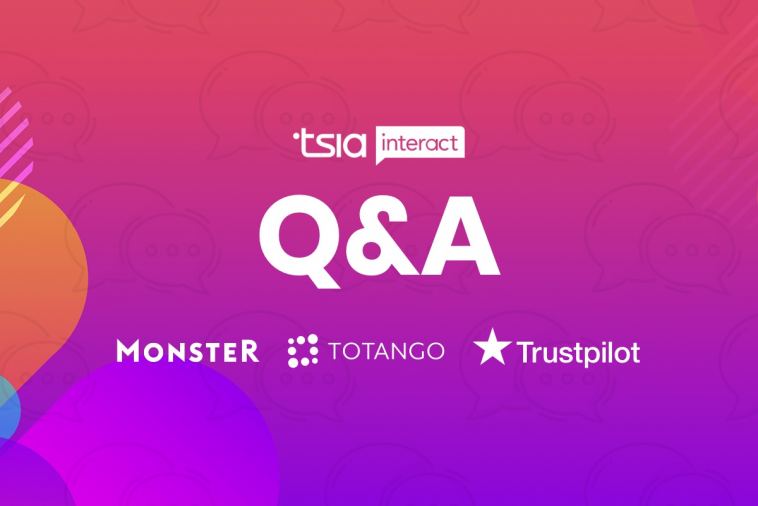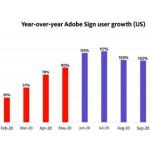- Like
- SHARE
- Digg
- Del
- Tumblr
- VKontakte
- Flattr
- Buffer
- Love This
- Save
- Odnoklassniki
- Meneame
- Blogger
- Amazon
- Yahoo Mail
- Gmail
- AOL
- Newsvine
- HackerNews
- Evernote
- MySpace
- Mail.ru
- Viadeo
- Line
- Comments
- Yummly
- SMS
- Viber
- Telegram
- JOIN
- Skype
- Facebook Messenger
- Kakao
- LiveJournal
- Yammer
- Edgar
- Fintel
- Mix
- Instapaper
- Copy Link
During the live presentation of the Technology & Services Industry Association (TSIA) Interact webinar “Mastering Scale with Digital Customer Journeys”, Totango CCO and COO Jamie Bertasi, Trustpilot Senior Global Director of Customer Marketing Taylor Cunningham, and Monster Senior Director of Customer Success and Client Adoption Karla Russel answered several questions from attendees. You can watch the webinar here and check out a recap of some of the questions and answers from the live session below.
How do you measure engagement rate?
KR: At Monster, we measure engagement rate by the number of people that actually click through the email. And, depending on what message we have in the email, what actions they take based on that message.
TC: At Truspilot, we have three key components that indicate to us if a business is getting value out of our platform or not and those are our basis for engagement. So, if they’ve completed those three actions, then we will say that they’re engaged, and if they have not, then we say that they aren’t engaged. From there, we decide which customer journey we put them down.
What are some of the strategies you have used to improve open rates?
TC: The lowest hanging fruit is always going to be testing your subject lines and evaluating your audience. There are two components that can contribute to your open rate: how compelling your message is and how interested your audience is in that message. So, if you’re seeing a low open rate even though you’re testing lots of different messages in your subject lines, then perhaps you don’t have the most engaged audience to begin with and you should be sending something a little bit more targeted or refine that audience a bit.
JB: It’s also about really making sure that the message that you’re delivering is getting there at the right time. So, it’s important to use your underlying data so that you know what the customers are doing, where they are in their journey and what they need at that time. At Totango, we find that people really like when we send very short videos and it’s very effective for us in terms of explaining things or introducing best practices and moving them along through the journey. Another thing we’ve learned along the way is not to have too many calls-to-action in the actual content. Sometimes we get overzealous and include too many CTAs, which depresses our response rate. So, sending very streamlined, short, to-the-point emails or engagements with your customers at the appropriate time is the most effective.
KR: We tend to leverage a lot of the data to meet people where they are in the journey and trickle in other content – whether it’s video articles, training, content marketing material, etc. – along the way to engage them. Sometimes this content just allows them to learn something new, which will make the experience and the engagement with Monster more valuable.
What advice do you have for visualizing the customer journey in order to ensure you are meeting the needs of your customers?
JB: You have to have some way of seeing and understanding what’s going on with your customers so you can see how the various pieces are fitting together based on your segments. We’ve seen most of our customers approaching how to put that visualization together in very different ways, and so, this is one of the things that we have built and are continuing to build into Totango. Customers can go into a SuccessBLOC and see how the entire program fits together for them and really understand where there are opportunities for them to optimize. It’s nice to be able to see open rates and engagement rates, but sometimes, when it’s laid out in a visual fashion, you can see that you have too many communications hitting a particular segment or the timing is off.
TC: The one thing that we really push ourselves to do, and it’s challenging, is focus on the user’s perspective. A lot of times, a user journey mapping exercise turns into a lead routing exercise, like what do we want them to do from Point A to Point B, when in fact, you need to think about the user himself. So, what we’ve done to help force that, is to isolate specific customers and go back in time and figure out what was their journey. When did they enter our ecosystem? What content did they interact with? When did they convert from free to paid? And we represent that visually with their headshot, logo, the review, the advertisement that they produced with review content in it, etc. So, we really focus on that user instead of the internal processes that we’re trying to force them through. And I think that helps, especially if you’re socializing this content across different departments.
JB: We do that also at Totango. We have meetings where we go through the journey for a particular segment and each individual in that segment. Oftentimes, we’ll go through 20 individuals just to see what their journey was, what’s happening, what’s working and what’s not working. From there, we can use the technology to fine tune and iterate. And then, the commonalities just jump off the page. All of a sudden, from these 20 random people from across the world, we see that 17 of them follow the exact same path. Despite their business, their background, etc., they do the exact same thing. It’s very interesting.
KR: We are in the process of re-envisioning our customer journey for our digital customers that will be coming through our new e-commerce platform. What we’ve realized with this new platform, is that we really need to go back and start from scratch. What do we learn in our existing customer journeys and what do we want to take from that? And then, what do we want to revise and iterate on? It’s about learning from what you’ve done in the past and being able to build on it because we’re constantly changing things in order to keep it fresh, to improve on the places where people are dropping off, or where we could do better.
How do you balance emailing too much when considering other communication initiatives?
TC: I think it’s really important for the stakeholders who are deciding which communications go to a certain audience and when to be a very small group and a group that coordinates consistently. Also, it’s important to have documentation like a calendar where communications are noted or just a cadence agreement that says something like lifecycle communications are going to fire on Tuesdays and Thursdays and ad hoc communications are going to fire on Mondays, Wednesdays, and Fridays. That’s a pretty low-fi solution, but at least you won’t be doubling up on the same day because you might be operating out of two systems.
JB: We also have a small group at Totango who manages this component of things to make sure that everything is streamlined and optimized. They meet weekly to talk about how things are going, look at responses and results. The other thing you want to consider is the look and feel of the brand element. You don’t want to have one team sending communications out that looks nothing like what another team is sending out. All customer marketing should have a similar look and feel.
TC: To add to that, from a look and feel perspective, we make an intentional choice in customer marketing to decide which communications appear to be written by the CSM and which look like they’re marketing or brand communications. I think that’s something to consider as well when you’re balancing the volume between the two. If you’re getting multiple emails on the same day, it’s a little bit easier to digest as a user if they’re all coming from a different point of contact than if they’re in the same format and all seem to be marketing communications.
How much of the automation and messaging is driven and iterated by Customer Success vs. Marketing?
KR: The person who did all of the automation for us in our company was originally part of the Sales organization and recently moved over to Marketing. They’ve maintained the responsibility to partner with us and to send these communications, but it’s been great because now they’re also part of the Marketing organization. They know everything that’s going on in addition to what they are doing with us, and we’ve really benefited from that. So, I think that whether the person who is helping you is in CS, Sales, Marketing or whatever, it’s just a matter of having a really close partnership and knowing what else is going on in the business.
TC: I’d also add that the Customer Success team is our greatest source of copy ideas. They’re already writing great emails, so just leverage those great emails and scale them.
Want to learn more about how you can use digital customer journeys to scale your business? Watch the full webinar here.



![how-to-build-a-market-development-strategy-[free-planning-templates]](https://everythingflex.com/wp-content/uploads/2021/06/8457-how-to-build-a-market-development-strategy-free-planning-templates-150x150.jpg-23keepprotocol)
